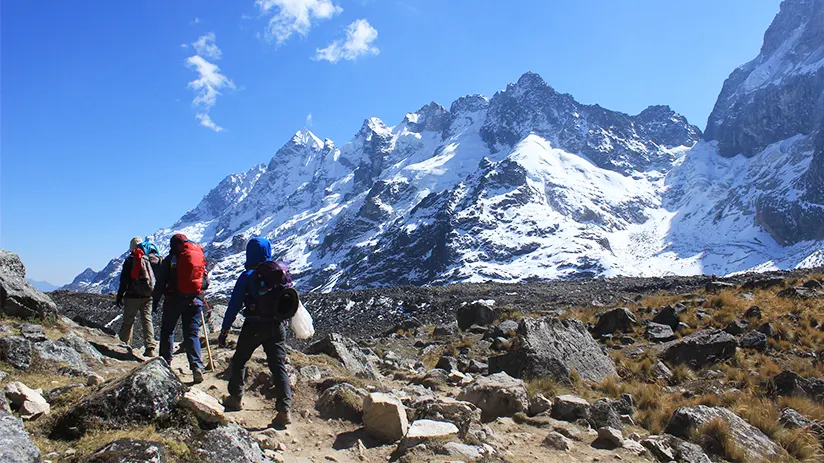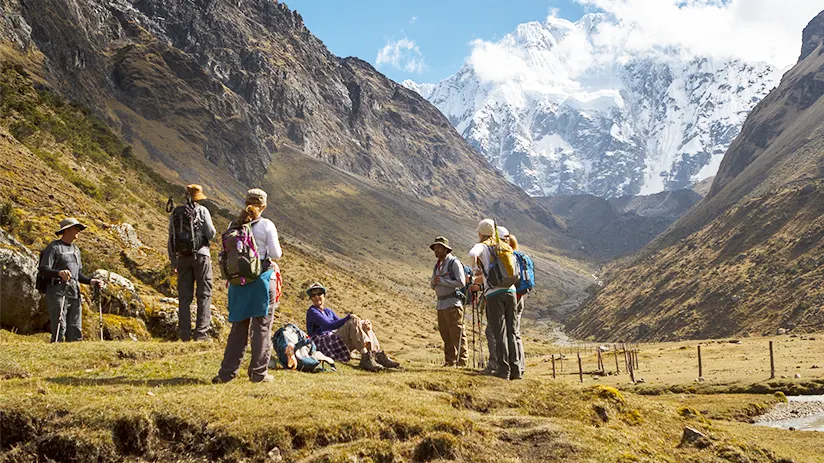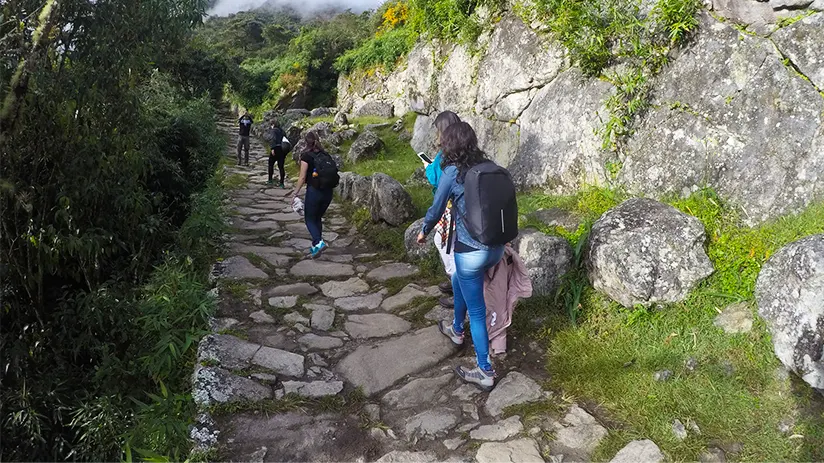Machu Picchu is not only history and beauty, it can be adventure too! This 2023, the Inca world wonder is totally open to visitors again. Without any COVID restrictions, the experience of hiking the different footpaths surrounding it will be amazing! And, on this occasion, the Cusco Peru Travel team wants to give you important facts about these beautiful paths, routes, and hikes. Multi-day hikes, one-days hikes, what you need to know before doing it, and our personal tips. Without further ado, let’s get started.
Everything you need to know about Hiking to Machu Picchu this 2023

Due to its inhospitable location in the middle of rainforest mountains, and its importance, Machu Picchu had access through many well-signed footpaths. These surrounded it and connected with other main Inca towns like Vilcabamba, Choquequirao, Ollantaytambo, and Cusco. Nowadays, visitors can walk the same trails used by the Incas centuries ago!
The Inca Trail to Machu Picchu is the most popular hiking in Peru and one of the most famous around the world. Of course, the trail was the main route originally used by the Incas to get to Machu Picchu. The footpath crosses Inter-Andean valleys, jungle brows, and cloud forests, in an extension of 31 miles. Also, the hiking lasts 4 days and 3 nights. Passing from 8202 feet to 13779 feet. The Peruvian Culture Ministry maintains and manages the trail. Therefore, any future trekker has to book their entrance to this route through an authorized travel agency. That means hiring a tour guide and porters, too. Because nobody can hike the Inca Trail by themselves.
Salkantay Trek is the second most famous trail in Peru. The trek allows one to pass by snow-covered slopes (specially Salkantay snow), rainforest mountains, and jungle valleys. All of this is around 44 miles of extension. Therefore, the hiking lasts 5 days and 4 nights. The extreme change of climates during this tour will be the most memorable. Consequently, the route pass from 5905 to 14763 feet. The route is not supervised by any institution yet. Therefore, the route doesn’t require any entrance, and all trekkers can hike it alone (It is well-signed). However, we always recommend doing it with a travel agency by logistic themes.
The trek of Lares has a good beginning as an end. All begin in Lares, a charming town located 107 kilometers from Cusco north. There, trekkers can enjoy natural hot springs before beginning the hike. The route crosses mountainous landscapes, glacial lakes of intense emerald color, and forests of queuñas around 21 miles of extension. Usually, trekkers take 4 days and 3 nights to complete the route, passing by 8202 to 13779 feet. The final is the same Ollantaytambo train station, where the hikers will be able to take one of many trains heading to Machu Picchu. The route is free, without any entrances. But, in the same way, we recommend hiring a travel agency to do it, (by logistic themes)
Many scholars indicate Choquequirao as the twin sister of Machu Picchu. Of course, its beauty and well-conserved structures are sufficient reasons to compare both attractions. Choquequirao is located 45 km southwest of Machu Picchu and 175 km west of Cusco. Consequently, its access is very limited, even these days. Happily, a signed footpath of 37 miles connects the Inca site with the modern town of Cachora, the starting point of the route. The footpath passes over beautiful slopes of inter-Andean valleys with warm weather and awesome jungle landscapes. Indeed, the hike lasts 5 days and 4 nights, passing by altitudes around 9940 feet. The experience is matchless, and it is crowed by the imponent Choquequirao.
Originally, Hiram Bingham, the famous American explorer, wanted to find Vilcabamba because it was the last place where the Incas established themselves in the jungle deep (against the Spanish invasion). But on the contrary, he encountered Machu Picchu in 1911 making it known to the world (Remember that Agustin Lizarraga, a Cusco farmer had found it 9 years earlier) However, Vilcabamba was just discovered and studied by another American Gene Savoy in 1964. Getting lost among its magnificent palaces of Inca style in the middle of the jungle is a unique experience. The trek begins in Huancalle Town (8 hours from Cusco northwest) and the trekker will pass by beautiful high jungle landscapes, with autochthonous flora and fauna. The hike lasts 5 Days and 4 nights, hiking around 45 miles, over an elevation of 12467 feet.
The Inca Jungle combines trekking, biking, zip-line, and even rafting in 4 days and 3 nights of full adventure. The route extension of 30 miles approx begins in Abra Malaga (105 km from northwest Cusco, to 4316 feet). From this point, the biking downhill will be heading to the jungle. After, on the second day, the adventure will continue with a rafting activity in the Vilcanota River. In the afternoon, the zip line activity will be relaxing for the trekkers. On the third day, trekking among the rainforest valleys will guide you up to Hidroelectrica Train Station. There, the trekkers will take a train heading to Aguas Calientes town, to visit Machu Picchu. It goes without saying that the beauty of the Peruvian jungle, its flora, and its fauna will enchant the hikers on this route.

Of course, the Inca Citadel offers 1-day hikes, too. These are in surrounding areas of the same Machu Picchu. Most of them are administered by the Peruvian government and require entrance fees. Its demand is high, so you must buy tickets even months in advance.
There is a mountain, with the same name as Machu Picchu, located behind the citadel. The hike offers unique views of Machu Picchu from a totally different angle. The footpath is wide with a moderate slope up to the top (7972 feet of altitude) And it is perfect for families. In addition, the hike lasts 02 hours one way and the same time to return (2 km of extension). Of course, it starts from the same Machu Picchu, and the path is well-signed. The entrance tickets include the visit to the same Machu Picchu citadel and come with a strict schedule of hiking (it has to be respected). The hike can be done alone. However, the trekker will need a tour guide for the Machu Picchu Citadel part (according to the Peruvian government policies) The entrances are sold out quickly, for this reason, buy them months in advance. Also, if you are on a Luxury Vacation in Machu Picchu, you can’t miss this activity.
In the same way, Huayna Picchu is another mountain located behind Machu Picchu (it is situated just a side of the previous namesake mountain with 8835 feet of altitude) And presents a steeper slope to its top. The hike starts from the same citadel and lasts 1 hour to climb up and another one to descend (2 km of extension). Of course, its top offer other amazing views of Machu Picchu. Also, the difference in front of Machu Picchu mountain hike is the archaeological sites found along the path like the Moon Temple among others. Indeed, the difficulty is high, so it is not recommendable for children or older people. Equal to the previous mountain, this hike requires entrance with a strict schedule (and it includes the visit to the citadel, too) These tickets sell out fast and have to be booked 6 months in advance at least.
Huchuy Picchu is the most recent hiking route in the Machu Picchu archaeological park. Just after the Pandemic, the Peruvian government enabled the route to this mountain situated over 8192 feet of altitude, next to Huayna Picchu. Its hiking is the easiest and takes only 1 hour, round trip (1 km of extension) The hike is short and the views from its top are the most remarkable. Like its predecessors, the route requires entrance with a determinate schedule of visits. Also, this ticket includes the entrance to Machu Picchu citadel.
The Sun Gate or the Inti Punku (In the Quechua language) is located inside Machu Picchu citadel. The Incas used it as a checkpoint for all visitant to the city. And, nowadays, it is the main entrance for those who come from Inca Trail. Its route is very easy but longer than the Machu Picchu mountain route (Although they are parallel) The hike lasts 3 to 4 hours round trip starting from the same Machu Picchu citadel, by the west side. The path is well-signed, and you will be fascinated by the views from this zone. In the same way, this hike requires an entrance ticket with a determined schedule of visits.
In the same way, the Inca Bridge is situated at Machu Picchu West, inside the citadel. In the Incas times, it was used as a frontier of the citadel with the jungle. Its surface is a wooden bark that was raised to prevent the passage of invaders, in the face of a threat. Consequently, the hike is a descent and lasts 20 minutes (one way) to reach it. This short hike doesn’t require any special entrance except the general entrance ticket to Machu Picchu. The visitor can get wonderful views of the citadel in a curve, just before reaching the Inca bridge.

Any hike, moreover in Machu Picchu, demands logistics, acclimatization, and knowing the best time to realize them. Remember that Machu Picchu is located in the Peruvian mountain range, specifically in the jungle eyebrow, and suffered the special weather conditions of the area. For this reason, we will list the three most important things to take into account before hiking to Machu Picchu.
The four seasons, well known by everyone, don’t apply in Peru, specifically in Machu Picchu. The Andean country has only two well-defined seasons, the rainy and dry seasons. The Rainy season goes in the mountain range from November to March and presents hard rains, cloudy skies, and gusts of cold. The average temperature is from 73 to 77 ºF. Of course, the footpaths, around and close to Machu Picchu, present muddy routes and landslides. For all these reasons, hiking in Peru in any of its forms, this season not is recommendable. Moreover, the Inca Trail is closed in February for maintenance.
On the other hand, the dry season goes from April to October. The average temperature is from 62 to 65 ºF. And it presents clear skies, hard sun rays, and warm days. Even, the high tourism season is between these months, like June, July, and August. Needless to say that this season is the best time to visit Machu Picchu and enjoy its hiking routes.
Machu Picchu is situated over 7972 feet, between the Peruvian mountain range and the jungle eyebrow. Thus, all the hiking routes surrounding it are situated around 6000 feet of altitude. That means a lot of height. For all these reasons, the acclimatization of the body previous to hiking to Machu Picchu will be crucial. Generally, the visitor who wants to travel to Machu Picchu first has to arrive in Cusco (due to the international airport located there). Cusco is situated at 11152 feet (higher than Machu Picchu) and the visitors, once arrived there, go directly to Sacred Valley (9420 feet) to avoid the altitude and begin their hiking to Machu Picchu. Big mistake.
Cusco (being at a higher altitude than Machu Picchu and its hiking paths) is perfect for acclimatizing. Stay there a couple of days before going to Sacred Valley or the starting point of any hiking is recommendable. In addition, don’t eat anything heavy or highly seasoned such as red meat or fish, avoiding physical exertion the first two days at altitude, will help the acclimatization. The consumption of Coca and muña tea on the first days is another factor to prevent altitude sickness. Following these recommendations, anyone with a minimum of hiking experience can hike to Machu Picchu, even a beginner.
As you can see, the hiking to Machu Picchu includes options for more than one day of activities. And many days mean many things to carry on, like tents, sleeping bags, and camping mattresses, besides entrance tickets, Cusco’s Touristic Ticket, permissions, and more logistics. For this reason, take your time to choose your hiking type to do and what you will need for it. For example, the Inca Trail requires a special entrance ticket besides special permission for a train stop (to start hiking). Without mentioning the camp equipment, food and more else. On the other hand, the Salkantay trek doesn’t require any entrance or special permission, but more logistics. Because the zones to pass have weather conditions different one from the other.

“I HAVEN’T BEEN EVERYWHERE, BUT IT’S ON MY LIST”
We hope we helped you to decide what kind of a hike to Machu Picchu realize and the previous steps to know before hiking. As you already know, the most important thing is the anticipation and the previous information about the hike to take. Our experts of the Cusco Peru Travel team are attentive to any question or requirement that any future trekker has about Peru or Machu Picchu. Don’t hesitate to contact us at any moment. Best regards.
As you can see there are many alternatives to hikes to Machu Picchu so depending on your available time and your hiking abilities, remember most of these treks you will need to book early, and for all of the treks you will need to use a licensed Peruvian agent. But all will be a lifetime memory for you and your traveling companions.
Peru has many wonders waiting for you to be discovered. Here in Cusco Peru Travel, our speciality is to make your trip an outstanding experience, fill-in this form and let your tailor-made luxury Peru vacation begin.
USA / CANADA
1 (800) 980-0435
Ready to start your engines? Let us know your schedule and destination, and we’ll take care of the rest.

